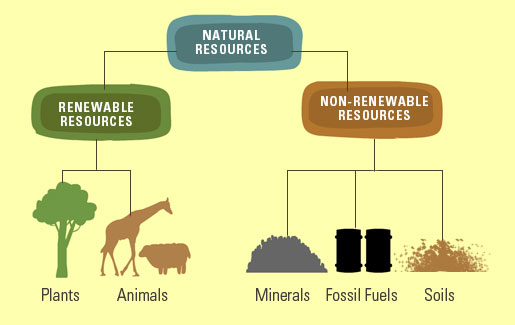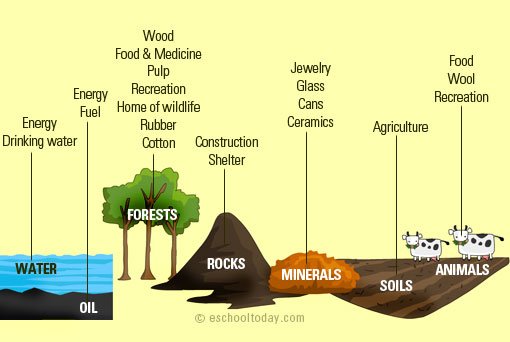The importance of conserving and managing resources for sustainability.
Ever since the earth was inhabited, we humans and other life forms have depended on things that exist freely in nature to survive. They are called Natural Resources and are the basis of life on earth. It may be in a form of renewable resources and or non-renewable resources.

Renewable resources are those that are constantly available (like water) or can be reasonably replaced or recovered, like vegetative lands. Animals are also renewable because, with a bit of care, they can reproduce offsprings to replace adult animals. Even though some renewable resources can be replaced, they may take many years and that does not make them renewable.
If renewable resources come from living things, (such as trees and animals) they can be called organic renewable resources.
If renewable resources come from non-living things, (such as water, sun, and wind) they can be called inorganic renewable resources.
Non-renewable resources are those that cannot easily be replaced once they are destroyed. Examples include fossil fuels. Minerals are also non-renewable because even though they form naturally in a process called the rock cycle, it can take thousands of years, making it non-renewable. Some animals can also be considered non-renewable because if people hunt for a particular species without ensuring their reproduction, they will be extinct. This is why we must ensure that we protect resources that are endangered.
Non-renewable resources can be called inorganic resources if they come from non-living things. Examples include minerals, wind, land, soil, and rocks.
Some non-renewable resources come from living things — such as fossil fuels. They can be called organic non-renewable resources.
Natural resources had a big part in our lives, particularly in our day to day living. It was given to us by our dear creator freely and wholeheartedly. We, humans, depend directly on forests for food, biomass, health, recreation and increased living comfort.On the other hand, forests act as climate control, flood control, storm protection and nutrient cycling. Sometimes, natural resources can be used as raw materials to produce something. We can use a tree from the forest to produce timber. The timber is then used to produce wood for furniture or pulp for paper and paper products. The tea mug, electricity at home, bread, clothes, you name them: each of them came from a natural resource. Every item in our home was made from a raw material that came from a natural resource.

In the USA, a baby is born every 8 seconds, and a person dies every 13 seconds. The increase in populations means there will be pressure on almost all natural resources.How? through the following resource consumptions:
Land Use: With more mouths to feed and people to house, more land will need to be cultivated and developed for housing. More farming chemicals will be applied to increase food production. Many forest or vegetative lands will be converted to settlements for people, roads, and farms. These have serious repercussions on natural resources.##
Forests: Demand for wood (timber), food, roads and forest products will be more. People will, therefore, use more forest resources than they can naturally recover.
Fishing: Freshwater and seafood will face problems too as we will continue to depend heavily on them. Bigger fishing companies are going deeper into the sea to catch fish in even larger quantities. Some of the fishing methods they use are not sustainable, thereby destroying much more fish and sea creatures in the process.
Need for more: Human's demand for a comfortable life means more items (communication, transport, education, entertainment, and recreation) will need to be produced. This means more industrial processes and more need for raw materials and natural resources.
If overpopulation continues in the coming years without taking any action to lessen it and if we continue to use such resources without limitations and without proper care and allocation, it may lead to various problems such as environmental degradation, over-consumption, resources curse, the tragedy of the commons and myth of superabundance.
In order make our natural resources sustainable and to have an environmentally sustainable secure future where we can still enjoy natural resources, we urgently need to transform the way we use resources, by completely changing the way we produce and consume goods and services.To turn this unfortunate way of life around, we all have to play a role.
Education and Public Awareness
All stakeholders must aim to provide information and raise public awareness about the wonderful natural resources we have and the need to ensure its health. Even though there is a lot of information in the public domain, campaigners must try to use less scientific terms, and avoid complex terminology to send the message across. Once people understand how useful our natural resources are, they will be better placed to preserve it.
Individuals, organizations and nations
People and organizations in developed nations with high resource consumption rates must be aware of the issues of natural resources. People should understand that it is OK to enjoy all the items and gadgets at home, but also, give back to the environment by way of reducing waste, recycling waste and becoming a part of the solution. We can achieve this in our homes and workplaces by reducing waste and also by recycling the waste we create.
Governments and Policy
Governments must enforce policies that protect the environment.
Thank you very much for stopping by! Hope you enjoyed reading and learned something.
Please also support @surpassinggoogle by voting steemgigs as a witness. Thank you.
Reference:
http://www.eschooltoday.com/natural-resources/types-of-natural-resources.html
You have received an upvote from @livesustainably. I promote and curate content that encourages and educates others in living sustainably. You can support the live sustainably cause on Steemit by upvoting, resteeming and creating content under the tag #livesustainably.
You can also benefit and support the cause by using the upvote bot @greengrowth.
Minimum bids from 0.01 SBD! The early adopters of this new bot have been receiving 100% upvotes! Wow!
Thank you very much. :-) Let's all together deepen environmental awareness and take care the environment.